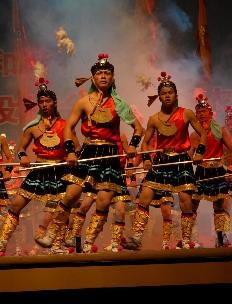“Tiao Ma Fu”: ritual dance of Rudong county

Tiao Ma Fu in Rudong county. [Photo/ntsfy.cn]
The traditional dance Tiaomafu is mainly found in Rudong county of Nantong, Jiangsu province, especially in Fengli town, Juegang town and Chaoqiao town, but it is also popular in Nantong’s Rugao, Haian and Tongzhou districts.
The historical origin of Tiaomafu can be traced back to ancient ancestral sacrificial customs. During the Spring and Autumn and the Warring States periods (770-221 BC), Rudong county was a dependent of the State of Chu. Due to later land reorganization ancestors came from almost everywhere. They were inclusive and learned from each other, creating substantial and unique folk and regional cultures through their long-term convergence. The Annals of Rugao county (Rudong was subordinate to Rugao in former times) states that the “the Chu people believe in gods and ghosts and are fond of worship ceremony. They invite wizards and witches to sing and dance to entertain the gods”, a culture that has spread up to today. The folk dance Tiaomafu was born in that historical context. Thus it can be seen that Tiaomafu has the cultural genes and the historical origin of the Chu people.
Tiaomafu today consists of a dance performed by a group of men of the Han nationality. It was originally a kind of ritual to offer sacrifices of burning Mafu joss stick to the Royal Highness Dutian. The people whose families had suffered misfortunes make a vow to the gods, to whom they voluntarily became servants. Mafu, swirling around the gods, expressed the people’s deep gratitude until death, their willingness to continue as slaves for the gods and to dedicate their services to gain their protection against calamities and bad luck. This was the original intention of the participants.
This kind of dance, featuring exceptional male dancers of the Han nationality and full of masculinity, is very rare among folk dances. Therefore experts such as the chief editorial department of China Folk Dances Integration are extremely interested in it. The dance has been presented on the stage and screen and internationalized for over twenty years, having a significant impact on cultural exchanges and art research.


